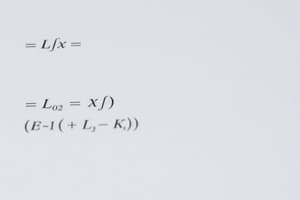Podcast
Questions and Answers
What does the derivative of a function represent?
What does the derivative of a function represent?
- The area under the curve of the function
- The rate of change of the function (correct)
- The value of the function at a particular point
- The endpoint of the function's domain
Which rule would you apply to differentiate the product of two functions?
Which rule would you apply to differentiate the product of two functions?
- Quotient Rule
- Power Rule
- Chain Rule
- Product Rule (correct)
What is the fundamental theorem of calculus primarily concerned with?
What is the fundamental theorem of calculus primarily concerned with?
- Identifying limits of functions
- Finding local maxima and minima of a function
- Calculating areas of irregular shapes
- The relationship between differentiation and integration (correct)
Which of the following does NOT describe a property of limits?
Which of the following does NOT describe a property of limits?
The indefinite integral of a function yields which of the following?
The indefinite integral of a function yields which of the following?
What is represented by the notation $
rac{dy}{dx} $?
What is represented by the notation $ rac{dy}{dx} $?
When would you use substitution in calculus?
When would you use substitution in calculus?
What is a critical point in the context of derivatives?
What is a critical point in the context of derivatives?
Which of the following is a technique used for numerical integration?
Which of the following is a technique used for numerical integration?
What does the notation $ ext{lim}_{x o c} f(x) $ signify?
What does the notation $ ext{lim}_{x o c} f(x) $ signify?
Flashcards are hidden until you start studying
Study Notes
Calculus Study Notes
Definitions
- Calculus: A branch of mathematics that studies continuous change, primarily through derivatives and integrals.
- Limits: The value that a function approaches as the input approaches some value.
- Derivative: Measures the rate of change of a function; represented as f'(x) or dy/dx.
- Integral: Represents the accumulation of quantities, such as areas under curves; denoted as ∫f(x)dx.
Key Concepts
-
Limits
- Notation: ( \lim_{x \to c} f(x) )
- One-sided limits: ( \lim_{x \to c^-} f(x) ) (left), ( \lim_{x \to c^+} f(x) ) (right)
- Properties:
- Limit laws (sum, product, quotient)
- Squeeze theorem
-
Derivatives
- Definition:
- ( f'(x) = \lim_{h \to 0} \frac{f(x+h) - f(x)}{h} )
- Interpretation: Slope of the tangent line to the graph of the function at a point.
- Rules:
- Power Rule: ( d/dx [x^n] = nx^{n-1} )
- Product Rule: ( d/dx [uv] = u'v + uv' )
- Quotient Rule: ( d/dx [u/v] = (u'v - uv')/v^2 )
- Chain Rule: ( d/dx [f(g(x))] = f'(g(x))g'(x) )
- Definition:
-
Applications of Derivatives
- Finding tangents and normals.
- Identifying local maxima and minima (Critical points).
- Analyzing function behavior (increasing/decreasing intervals).
-
Integrals
- Definite Integral: Represents the area under a curve from a to b:
- ( \int_a^b f(x)dx )
- Indefinite Integral: General formula for antiderivatives:
- ( \int f(x)dx = F(x) + C )
- Fundamental Theorem of Calculus: Connects derivatives and integrals:
- If F is an antiderivative of f, then:
- ( \int_a^b f(x)dx = F(b) - F(a) )
- If F is an antiderivative of f, then:
- Definite Integral: Represents the area under a curve from a to b:
-
Techniques of Integration
- Substitution
- Integration by parts
- Partial fractions
- Numerical integration (Trapezoidal rule, Simpson’s rule)
Important Applications
- Modeling physical systems with rates of change (velocity, acceleration).
- Area and volume calculations for geometrical figures.
- Solving differential equations that describe dynamic systems.
Notation Summary
- ( f'(x) ): Derivative of f with respect to x.
- ( \int f(x)dx ): Indefinite integral of f.
- ( \int_a^b f(x)dx ): Definite integral of f from a to b.
- ( e^x ), ( \ln(x) ): Exponential and logarithmic functions often used in calculus.
Important Limits and Derivatives
- ( \lim_{x \to 0} \frac{\sin x}{x} = 1 )
- ( \frac{d}{dx} e^x = e^x )
- ( \frac{d}{dx} \ln x = \frac{1}{x} )
Understanding these concepts is crucial for advanced study in mathematics and its applications in science, engineering, and economics.
Calculus
- Calculus studies continuous change, primarily using derivatives and integrals.
- Derivatives measure rates of change, while integrals represent accumulation.
Limits
- A limit is the value a function approaches as its input approaches a specified value.
- Notation: ( \lim_{x \to c} f(x) ) represents the limit of f(x) as x approaches c.
- One-sided limits approach c from either the left (( \lim_{x \to c^-} f(x) )) or right (( \lim_{x \to c^+} f(x) )).
- Limits have properties like sum, product, and quotient laws, as well as the Squeeze Theorem.
Derivatives
- The derivative of a function measures the instantaneous rate of change at any point.
- Notation: ( f'(x) ) or ( dy/dx )
- The definition of the derivative is: ( f'(x) = \lim_{h \to 0} \frac{f(x+h) - f(x)}{h} )
- Derivatives graphically represent the slope of the tangent line to the function at a given point.
- Power Rule: ( d/dx [x^n] = nx^{n-1} )
- Product Rule: ( d/dx [uv] = u'v + uv' )
- Quotient Rule: ( d/dx [u/v] = (u'v - uv')/v^2 )
- Chain Rule: ( d/dx [f(g(x))] = f'(g(x))g'(x) )
Applications of Derivatives
- Derivatives are used to find tangents and normals to curves.
- They help identify local maxima and minima (critical points).
- Derivatives analyze function behavior, determining increasing or decreasing intervals.
Integrals
- The definite integral represents the area under the curve of a function between two specified points.
- Notation: ( \int_a^b f(x)dx ) represents the definite integral from a to b.
- The indefinite integral represents the general formula for all antiderivatives.
- Notation: ( \int f(x)dx = F(x) + C )
- The Fundamental Theorem of Calculus establishes a connection between derivatives and integrals:
- If F(x) is an antiderivative of f(x), then ( \int_a^b f(x)dx = F(b) - F(a) ).
Techniques of Integration
- Substitution: Simplifies the integrand by substituting a new variable.
- Integration by parts: Uses the product rule in reverse to evaluate integrals.
- Partial fractions: Decomposes rational functions into simpler fractions for integration.
- Numerical integration: Uses methods like the Trapezoidal rule and Simpson’s rule to approximate definite integrals.
Important Applications of Calculus
- Modeling: Calculus models physical systems with rates of change (velocity, acceleration).
- Geometry: Calculus calculates areas and volumes of geometric shapes.
- Solving Differential Equations: Calculus helps solve equations describing dynamic systems in various fields.
Important Notation
- ( f'(x) ): Derivative of f(x) with respect to x.
- ( \int f(x)dx ): Indefinite integral of f(x).
- ( \int_a^b f(x)dx ): Definite integral of f(x) from a to b.
- ( e^x ) and ( \ln(x) ): Exponential and logarithmic functions often used in calculus.
Important Limits and Derivatives
- ( \lim_{x \to 0} \frac{\sin x}{x} = 1 )
- ( \frac{d}{dx} e^x = e^x )
- ( \frac{d}{dx} \ln x = \frac{1}{x} )
Studying That Suits You
Use AI to generate personalized quizzes and flashcards to suit your learning preferences.




